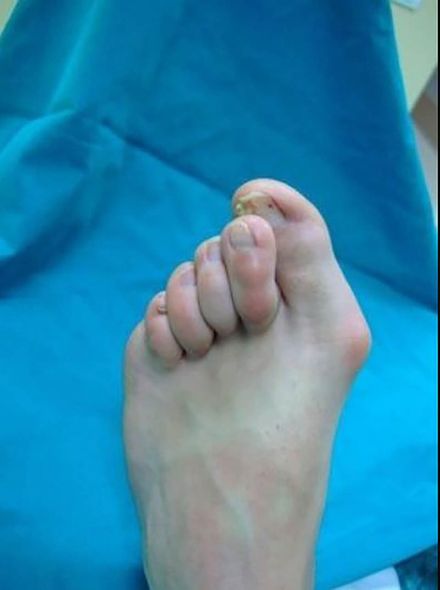
Hallux valgus
What is the hallux valgus?
Hallux valgus is a common foot condition characterised by:
- Medial deviation (towards the inside) of the first metatarsal.
- Outward displacement of the big toe, associated with rotation in severe cases.
- Deviation of the tip of the big toe towards the other toes.
- Formation of a bony prominence, associated with soft tissue enlargement.
How does it manifest?
This condition can cause intense pain and limited movement of the big toe, leading to more or less disabling deformities. The pain is usually located at the medial prominence and may be associated with increased volume and redness. Wearing closed shoes and walking without custom insoles or footwear can be challenging. In cases of severe hallux valgus, there may be a painful conflict between the big toe and the second toe. Altered sensitivity of the big toe, especially dorsally, may also be present.
How is it diagnosed?
The diagnosis is usually clinical, with the patient complaining of deformity and forefoot pain. Clinical diagnosis should be further investigated with weight-bearing foot X-rays, which assess the degree of valgus and any associated deformities. Magnetic resonance imaging may be indicated in cases of suspected degeneration of the metatarsophalangeal joint, especially if there is significant inflammation of the soft tissues adjacent to the medial prominence. Baropodometry and gait analysis can be useful to study biomechanical alterations in weight-bearing or during walking.
Does it affect men or women more?
Particularly which age group?
It is a disorder that more frequently affects women than men. There is an increase in incidence proportional to age. In the United Kingdom, it is reported that 3% of people are affected between the ages of 15 and 30, 9% between 31 and 60 years, and 16% in people over 60 years.
What are the causes of hallux valgus?
The causes can be biomechanical, traumatic, or metabolic.
Biomechanical causes are the most common and are related to flat feet (with hindfoot pronation), retraction of the Achilles tendon or gastrocnemius, varus forefoot, dorsiflexion of the first ray, first metatarsal shorter than the second, and ligamentous laxity.
The most common metabolic causes include gout, rheumatoid arthritis, psoriatic arthritis, and connective tissue disorders such as Down syndrome, Marfan syndrome, and Ehlers-Danlos syndrome.
Are there risk factors or categories prone to the onset of the condition?
Risk factors include a family history of the condition, rheumatoid arthritis, and the presence of ligament laxity. Pregnancy itself can be correlated with the onset of this condition. The use of very narrow or high-heeled shoes can influence the clinical course of hallux valgus, accelerating the biomechanical changes that lead to its onset.
What consequences does it have on the affected person's physique?
What damage can the foot suffer?
What about posture?
This condition leads to an imbalance of the foot, where the first ray becomes insufficient, biomechanically less efficient. The load during the push-off phase shifts to the heads of the 2nd and 3rd metatarsals, which can become inflamed, resulting in transfer metatarsalgia. Involvement of the overlying joints is rarer, usually attributed to coexisting hindfoot pronation.
In cases where there is no genetic predisposition or congenital malformation, how can the onset of this condition be prevented? Can it be done from childhood?
The onset of this condition can be delayed in cases where the etiology is biomechanical, with the use of custom insoles and footwear. For example, in flat feet, using an insole that supports the arch can decrease the forces pushing the metatarsal outward. If there is hindfoot deformity, corrective interventions can be performed to improve foot biomechanics even before development.
What treatments can be performed for the reduction or elimination of the problem?
Hallux valgus is a complex deformity, and depending on the degree of deformity and the patient's general condition, non-invasive therapeutic approaches or surgery can be considered.
To alleviate the problem or in cases where surgical intervention is not possible due to the patient's general condition, adapting or modifying footwear, using insoles or silicone orthoses to improve biomechanics can be considered. Physical therapy may be useful to reduce muscle-tendon tension and alleviate symptoms.
If conservative therapy is unable to reduce the patient's symptoms, surgical intervention is indicated to restore function, correct the deformity, and alleviate symptoms.
There are multiple surgical options chosen based on the etiopathogenesis of the deformity. The most common procedures include:
- Resection of the bony prominence
- Capsuloplasty
- Tendon rebalancing
- Resection arthroplasty
- First metatarsophalangeal fusion
- Cuneometatarsal fusion
- Arthroplasty
The most commonly used procedure is the osteotomy of the first metatarsal, which can be:
a) Distal: in cases of mild or moderate hallux valgus, performed at the neck of the metatarsal.
b) Proximal: in cases of severe hallux valgus, performed at the base of the metatarsal.
c) Diaphyseal: performed with an osteotomy involving the entire shaft of the metatarsal.
Joint fusions and joint prostheses are indicated if there is significant cartilaginous degeneration of the head of the first metatarsal or the base of the proximal phalanx of the big toe.
Are there contraindications for the surgical intervention?
The intervention is contraindicated in patients with vascular alterations that may affect the healing of the surgical wound, leading to gangrene and, in some cases, loss of the toe. Neuropathies, gout, and spasticity must be carefully evaluated before considering surgical intervention.
How important is physiotherapy after the operation and how should it be done?
Physiotherapy is recommended after 30 days post-operation and aims at restoring the mobility of the joints of the first ray. Rehabilitation is crucial to prevent the onset of joint stiffness and for the functional recovery of the foot.









